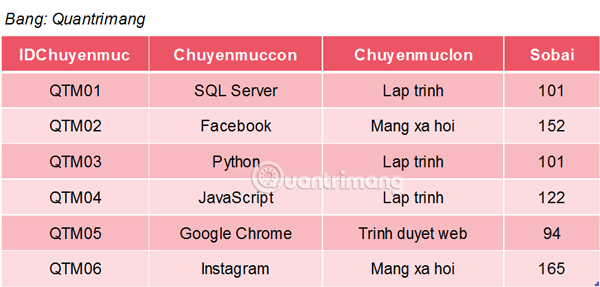COUNT function in SQL Server
This article will show you in detail how to use functions that handle COUNT () numbers in SQL Server with specific syntax and examples to better visualize and capture functions.
Describe
The COUNT function in SQL Server is used to count the number of records (data, rows) contained in a data table. The values NULL omitted do not count.
Syntax
To use the COUNT function in SQL Server, we use the following syntax:
SELECT COUNT(cot)
FROM bang
[WHERE dieukien];
Parameters :
- cot: column or calculated value, the expression you want to count
- state: the table used to retrieve the record. Must have at least 1 table in the FROM clause.
- dieukien: optional. Conditions that the record must meet to be selected.
Note :
- The COUNT function can be used in later versions of SQL Server: SQL Server 2017, SQL Server 2016, SQL Server 2014, SQL Server 2012, SQL Server 2008 R2, SQL Server 2008, and SQL Server 2005.
For example
Take a look and explore some examples of COUNT functions in SQL Server.
Suppose, we have the following data table:

Example 1: Count the number of categories in the table
SELECT COUNT(*)
FROM Quantrimang
WHERE Sobai > 100;
Result: 5
In this example we count the number of categories in the Quantrimang table that are larger than 100.
Example 2: Use DISTINCT
The DISTINCT and COUNT commands can be used together to count the number of duplicate results.
SELECT COUNT(DISTINCT Sobai)
FROM Quantrimang
WHERE Sobai > 100;
Result: 4
This example uses the keyword DISTINCT, so the repeated values are counted only once. In the given data table, the value '101' appears twice, but only once, so the total number of calculated lines will be 4.
Example 3: Using GROUP BY
The following example counts all records related to a large section and you will do the following:
SELECT Chuyenmuclon, COUNT(Chuyenmuccon) AS "So luong"
FROM Quantrimang
GROUP BY Chuyenmuclon;
Result:
Chuyenmuclon So luong
Laptrinh 3
Mang xa hoi 2
Trinh duyet web 1
Previous article: CEILING function in SQL Server
Next lesson: FLOOR function in SQL Server
 MAX function in SQL Server
MAX function in SQL Server MIN function in SQL Server
MIN function in SQL Server ROUND function in SQL Server
ROUND function in SQL Server SIGN functions in SQL Server
SIGN functions in SQL Server SUM function in SQL Server
SUM function in SQL Server CURRENT_TIMESTAMP command in SQL Server
CURRENT_TIMESTAMP command in SQL Server